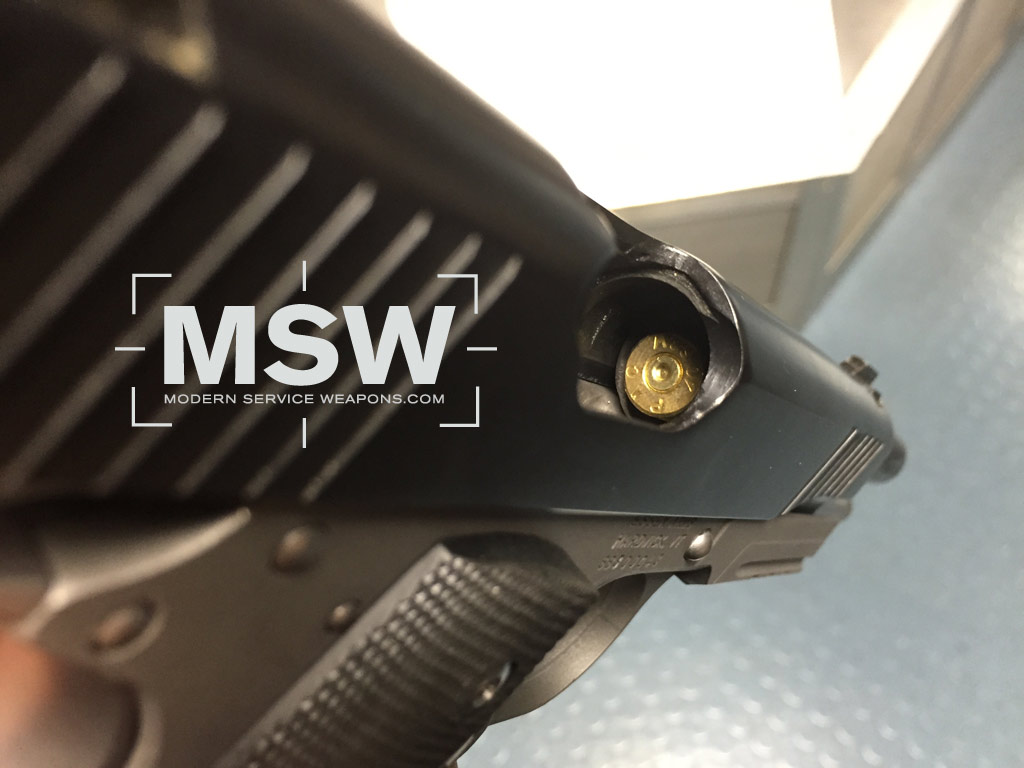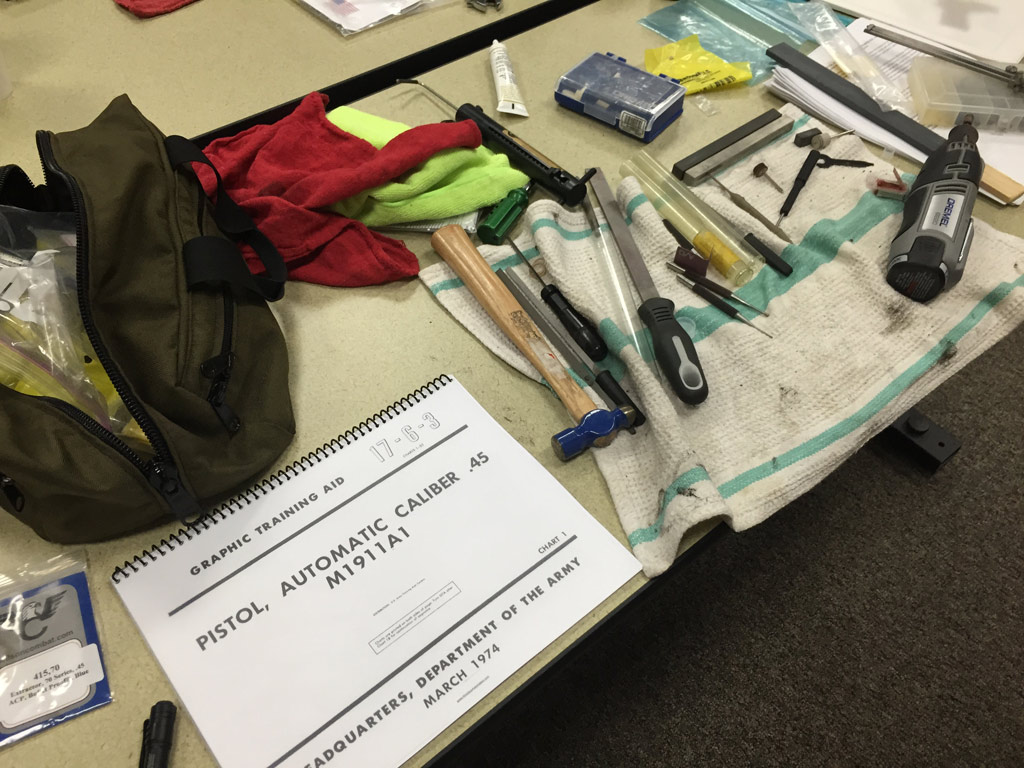
Here I am blending a grip safety for a student. This is normally far beyond the scope of the class, but this student has been carrying this pistol on duty and I couldn’t bear to see the frame cutting into his hand any longer.
Last month, we trekked out to the last frontier known as the State of Alaska, to do a 1911 Advanced Armorer’s Course to the fine folks at Anchorage PD. I enlisted the help of Colt 1911/M16 Armorer Instructor Dean Caputo to help me out with getting some of the guns to run correctly. I was pleasantly surprised to discover that though the agency authorizes the carry of 1911s to folks who meet their requirements, the vast majority of the SWAT guys in our class chose to carry something a bit more modern and forgiving of the extreme elements in which these guys work.
As usual, the class began with an overview of the 1911 pistol, its variants, and basics on how to detail strip the pistol to its component parts and put it all back together. Since we had different makes throughout the 24 student class, the varied approaches different manufacturers use to build the guns (e.g. different FP block devices, built in locking devices, etc.,) required many students to modify their approach from what John Browning originally had in his mind.

One of the the many malfunctioning guns we saw in class. This one was due to poor extractor tension. Once addressed, the gun was up and running.
One of the real nuggets we offer in our classes is the 1911 Reliability Protocol, which includes the 1911 Extractor Test (click the link for more information.) The protocol was designed to give end users a way to evaluate all of the critical functions of the pistol without requiring hundreds of rounds fired (which people won’t do.) We don’t give the full details here as the test on its own wouldn’t mean anything outside the context of the class (and is beyond the scope of this article), but don’t fret, I am working on getting it out there for the public to see. You can probably infer at least part of the test from the photo above.
Of the 24 1911 pistols (of various makes and models) in class, only five of them passed. Now that doesn’t mean that 19 of them would have immediately malfunctioned in a gunfight, causing the demise of the person carrying it, but it does mean that something in the pistol was not right. Maybe the slide didn’t lock back on empty mags, or it didn’t feed reliably from slide lock, or didn’t like to feed/chamber when shooting strong hand only.
Luckily, with Dean’s help along with the trusty cordless Dremel, we got all of them working. The class went 8 hours each day, with very short bathroom and lunch breaks, and many folks stayed afterward to work on their pistols or ask questions. I look back to my Glock Armorer’s Course, which was 20 minutes of material crammed into 8-hours. Yes, we left early.





Interesting that so many pistols failed the various tests. I would argue that is a good reason to become your own armorer and carry a second gun. Good article.
The failure rates for this class mirror the other classes we have done. This is to be expected when there is a complete mix of makes and models of 1911s. I would surmise that if all the guns were newer production Colts, the pass rate would increase, as Colts have really raised the bar on small parts quality and dimensional QC for a service/production grade 1911.
Has colts quality dropped at all since there bankrupty ?
So far as I can tell, they are making the guns as they always have.
Colt’s Chapter 11 filing is a debt restructuring move. Their production levels are at full throttle on both pistols and rifles and no QC standards have been changed or relaxed.
Sorry, I meant bankrupcy, good article!
Please please please bring this class back to Peoria,AZ. I was just getting started working with 1911s last time you were here and missed out.
I’d pay just for a class on properly fitting an extractor !
Tim:
Thank you for the great information regarding Colt. Do you typically see Wilson Combat 1911’s at the Armorer’s Course? If yes, how do they compare in terms of fit and functionality compared to the other brands?
Thanks much.
Overall, the WC are very well executed and the current guns are probably the best that have ever come out of that shop.
Can you post the complete list of tools, parts and supplies needed for the 10-8 1911 Armorer’s class? I’m poor and would like to buy these items in advance as my pockets aren’t deep enough to pay for plane ticket, hotel, car, class fee and tool/parts list all at once.
Is this test valid only for 1911 extractors? My Glock 26 will almost always drop the round down the mag well if there is no mag in the gun when fired. (The G26 has yet to jam with 3-4k rds though it).
The test does not translate directly over to Glocks or other platforms due to differences in the magazine/follower design. Read the linked article in the post for further information.
However, Tim, the test does expose Glock’s notoriously inconsistent extractor performance. Several factors influence that roller coaster level of performance, but what Darryl Bolke and I have noted for several years is the erratic ejection of the line is caused by an extractor losing tension on fired cases during the extraction step. This causes those “lost” cases to strike the ejector at various angles, or not strike it at all, and therefore produce what we call “lawn sprinkler” ejection.
The 10-8 test may not be completely applicable to Glocks, but it is telling. What’s really funny is that when you run the test on an HK pistol, you get a boring pile of brass where it belongs for as long as you want to run the test. There are more than a few clues there and the 10-8/Hackathorn Extraction Test is useful for a diagnostic of any service pistol.
Just for clarification, the extractor test is not ours, but borrowed from what I learned from Vickers. We uncorporate that test into our reliability protocol.
And yes, the performance of the Glock extractors is indeed telling. It is not ideal as even the older “properly” working Glocks will usually fail this test yet work fine in real world due to the magazine design. The 99% answer for Glock is the Apex Failure Resistant Extractor for Glock. I do wish they came 100% right from the factory but even adding the price of the Apex part to Blue Label LE price, the Glock in 17/19 format is a great value.
My casual observation based on my personal experience with 1911s is that, given the dramatic differences in designs, tolerances and quality control of the different brands, it would be better not to use one for duty or defense unless you have been to an armorer course exactly like this one. That way, if your extractor loses tension, etc., then you’re not relying on someone else to get your gun to run. That is why I love and respect my 1911, but have all but retired it in favor of Glocks and HKs, with the exception of when I go behind enemy lines back to New York to visit family, where it’s compliant with the despicable SAFE Act.
Tim,
How have the most recent crop of Springfield 19ll Operators faired with your testing protocols?
The TRP models have been hit or miss in terms of small parts quality and dimensional consistency. But reports from at least one well regarded gunsmith indicate the latest ones have significantly improved quality. I still stand by my recommendation of the Colt Rail Gun for a service grade railed 1911 pistol.